Photography By Adam Campbell
When talk turns to full-dress touring motorcycles, a few key words stand out: features, power and comfort. Oh, and did we mention features? Typical touring riders like to bring everything but the proverbial kitchen sink with them; they also want all the bells and whistles engineers can throw their way, making long days in the saddle as enjoyable as possible.
Kawasaki hasn't had a serious touring contender in years. The last time it had a full dresser in the lineup was back in 2003 with the long-in-the-tooth, inline-Four Voyager XII. And until the introduction of thisnew Voyager 1700, no Japanese company had dared tread on the holy ground of good ol' American V-Twin touring bikes, occupied primarily by Harley-Davidson and its Ultra Classic Electra Glide, with Victory joining the party with its Vision Tour in 2008. But the complete revamping of the Vulcan family was a great opportunity to introduce the first-ever metric V-Twin full-dress touring machine as the clan's patriarch.
Copying formulas of those aforementioned brands would do little to benefit Team Green, so it instead did what it does best: pack the Voyager with technology to enhance the riding experience, all the while keeping it hidden behind retro-themed styling. Some of the tech features that make this bike stand out are a sophisticated Electronic Throttle Valve system (ETV), ABS with Kawasaki Advanced Coactive Braking Technology (K-ACT) and all the touring amenities buyers expect.
Key to the entire Vulcan line is the new liquid-cooled, 1700cc, 52-degree, long-stroke V-Twin. A single-pin crank gives the engine that classic Vee character, while twin counterbalancers keep it smooth. The cylinder heads feature a single-overhead-cam arrangement in place of the Vulcan 2000's pushrods for improved mid- to high-rpm power. Semi-dry-sump oiling allows lower placement of the crankshaft, permitting a long, 104mm stroke without increasing engine height; bore measures 102mm. Kawasaki claims 108 foot-pounds of torque at just 2250 rpm.
One difference between the Voyager (and its close sibling, the Nomad bagger) and the Classic/LT Vulcan 1700s, which share the same basic engine, is that peak power and torque are moved 500 rpm higher in the rev range, where engineers felt touring riders could better utilize it on the highway. ECU mapping and changes to the exhaust are responsible for this difference, but out on the open road we found the sensation of extra power was negligible.
This is mostly due to the fact that both fifth and sixth gears in the transmission are true overdrives, with 0.967 and 0.806 ratios, respectively. On our introductory ride through California farm country and small towns like Bodega and Sebastopol north of San Francisco, neither of those top two cogs were needed and were only selected during a couple of short freeway stints. At 70 mph in sixth, the analog rev-counter registered a low-down 2500 rpm, while that same speed in fifth netted 3000. But we're sure when buyers let the "Good Times Roll" through the Midwestern U.S., good fuel economy and the ultra-smooth top-gear thrum will be welcome.
Response from the sophisticated fuel-injection system, which features a fully electronic fly-by-wire throttle arrangement, was very good. Optimal fuel delivery was maintained regardless of right-wrist input or prevailing conditions. Acceleration was strong, with particularly good roll-on performance in third and fourth gears. In the power department, our seat-of-the-pants impressions place the Voyager ahead of the H-D Ultra Classic Electra Glide we tested in the May issue. A 28mm-wide carbon-fiber-reinforced belt final drive sends power to the rear wheel.
Handling is the last thing you want to worry about when loaded down with a passenger and luggage. A 4.4-pound-lighter—yet 40 percent more rigid—steel double-cradle frame is more compact than that of the previous Vulcan 1600, allowing a shorter, 65.6-inch wheelbase. Curvy roads were quite enjoyable; never once did the Voyager exhibit anything that could be described as wallow. Only its limited bank angle held it back; the floorboards frequently carved crescents into the asphalt. Slow-speed maneuvers were also a non-issue. The Voyager carries its weight low, which made getting into and out of parking spaces easy, aided further by the low 28.7-inch seat and firm footing afforded by it.
The beefy 45mm fork and dual shocks that feature air-adjustable preload are largely responsible for making the 895-pound machine (claimed curb weight) handle so competently. Up to 43 psi of pressure can be run in the twin shocks to compensate for a passenger and luggage, in addition to four rebound settings. We ran 25 psi, pumped up via a Schrader valve on the upper outside of each shock body with a small Kawasaki accessory hand pump.
An option box that buyers will surely want to check is for the K-ACT ABS brake system, which adds $1100 to the $16,799 base price. Basically, the system interprets the rider's inputs at the front lever and rear pedal to determine if the pressure applied is correctly balanced. If not, the ECU either increases or decreases pressure fore and aft to optimize braking efficiency. ABS is incorporated as an added safety net. The system is completely transparent—you would never know that anything out of the norm was occurring during braking. To make sure that the system is not intrusive, it doesn't intervene at speeds below 12 mph, while ABS doesn't kick in below 4. Braking hardware comes in the form of triple 300mm discs, four-piston calipers in front and a two-pot binder out back.
Although we only had half a day aboard the Voyager (we sampled all four Vulcans over two days), it was clear that this is a bike that has a voracious appetite for all the miles that 5.3 gallons of on-board fuel will provide in one sitting. The deep-dish seat is plush yet supportive, the reach to the bars neutral, and wind protection provided by the tall screen envelops the rider in a quiet (no earplugs needed), still pocket. Vents in the lower fairing in front of the floorboards are adjustable to help cool the cockpit on hot days.
Like any good touring rig, the Voyager has ample creature comforts to keep rider and passenger entertained and happy. Click on the cruise control and fire up the 40-watt audio system that is intercom-headset compatible, iPod/MP3-ready (with optional cord) and can be fitted with an XM tuner or CB radio in addition to its FM/AM/WX head unit. If those are not enough gizmos for you, three power ports—one on the dash and two under the seat—can send juice to a GPS, radar detector, heated apparel or whatever else you can't do without on the road. Don't worry about overloading the electrical system because the Voyager has a liquid-cooled, rare-earth-magnet alternator that pumps out 48.5 amps.
Storage is what dressers are all about, right? Twin 38-liter, top-opening, lockable, hard-shell side cases are color-matched and weather-sealed, as is the 50-liter side-opening top case that will swallow two full-face helmets...or that small kitchen sink. Two more lockable compartments in the cockpit hold smaller items that you need to keep closer, such as your iPod that plugs into the audio system inside the cubby hole on the rider's left.
Inspiration for the Vulcan's styling comes from 1960's muscle cars, says Kawasaki, and at least the face of the audio systemisreminiscent of 8-track players of the era. The frame-mounted fairing features a single center headlight flanked by a pair of 35-watt driving lights; bright LED taillights on the rear fender are supplemented by two more rows of LEDs in the back of the top case. Twin chromed exhausts exit one to a side, allowing better cornering clearance and room for the side cases. Nine-spoke cast wheels are mounted with fat 130/90-16 front and 170/70-16 rear tires.
Cockpit styling is retro-modern. Fuel, speedometer, tachometer and coolant temperature are analog while a large LCD screen in the center displays gear position, fuel gauge, clock, odometer, dual tripmeters, remaining range and average fuel consumption. A switch on the right handlebar controls all LCD functions.
A thumbnail comparison between the Kawasaki and its two strongest adversaries, the Ultra Classic and Vision Tour, has the Voyager looking like a great deal at $17,899 with ABS, in either blue/black or titanium/black. As tested, the 1700 is $3100 less expensive than a base Ultra Classic and $2100 less than the base-level Vision Tour; the money saved would go a long way toward purchasing accessories.
Kawasaki's first entry into the metric V-Twin dresser category has all the markings of success. Lots of high-tech features, nice styling, long-term comfort and power that will likely help the Voyager out-sprint the competition should make the incumbents nervous.











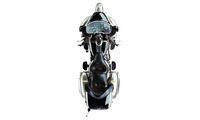
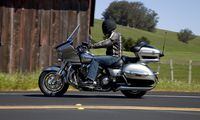
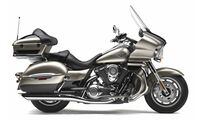
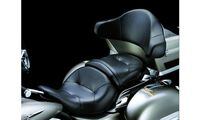
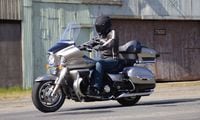
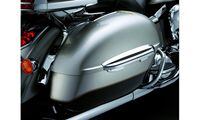
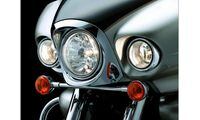
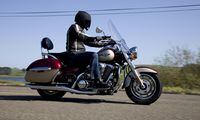
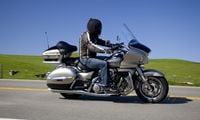

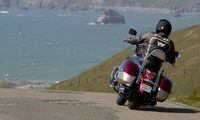
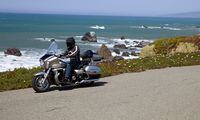
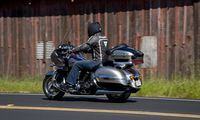
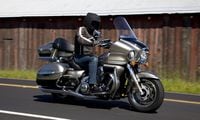
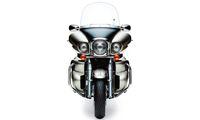
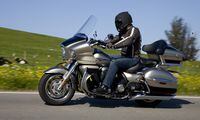
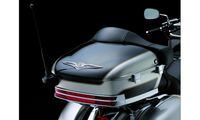

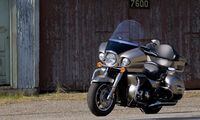
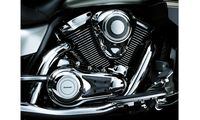
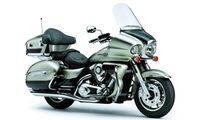
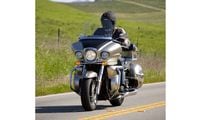
/cloudfront-us-east-1.images.arcpublishing.com/octane/EFFSPCZVBBCMTNGVEQMB7NNKIU.jpg)
/cloudfront-us-east-1.images.arcpublishing.com/octane/5GP3PUGFKVGUVCEYG4ZBDYLNBE.jpg)
/cloudfront-us-east-1.images.arcpublishing.com/octane/USTSFGXT3ZGL7BT7B66WMSSKTI.jpg)
/cloudfront-us-east-1.images.arcpublishing.com/octane/Z7YU6FSR6NEKVMKT5CZPMKIVLE.jpg)
/cloudfront-us-east-1.images.arcpublishing.com/octane/MOP35BTV3FFANFBUJKU2RJRTZ4.jpg)
/cloudfront-us-east-1.images.arcpublishing.com/octane/UWTN4NTIJFD25MPXBOVS4DFOXE.jpg)
/cloudfront-us-east-1.images.arcpublishing.com/octane/SIFOY54XMFGEHAUYNFUYVW7IZ4.jpg)
/cloudfront-us-east-1.images.arcpublishing.com/octane/HMC5X3JZHRASXGVCVNBJBWWGSI.jpg)
/cloudfront-us-east-1.images.arcpublishing.com/octane/UIWGXRZDM5HZXJOWXET2DZIWJE.jpg)
/cloudfront-us-east-1.images.arcpublishing.com/octane/QSS5DZ6SKJEU3AKE4KDAWYBEFY.jpg)
/cloudfront-us-east-1.images.arcpublishing.com/octane/SMCEQCLWRVEFTJJES6TAHB3OOQ.jpg)
/cloudfront-us-east-1.images.arcpublishing.com/octane/JCACIDCAC5FUNPTXO2BOUHGGII.jpg)
/cloudfront-us-east-1.images.arcpublishing.com/octane/DC7ZGILA2BCJXHZIUNYGV7JSEA.jpg)
/cloudfront-us-east-1.images.arcpublishing.com/octane/EWJEZUGWEZGABDEQWB64WL46GQ.jpg)
/cloudfront-us-east-1.images.arcpublishing.com/octane/5NHBMRMSFVD5JAPFNMBMNPGXQE.jpg)
/cloudfront-us-east-1.images.arcpublishing.com/octane/WHE43SCPLJBRNANAJAGXHOAIEU.jpg)
/cloudfront-us-east-1.images.arcpublishing.com/octane/6R56AQAW6NDE7BBIJ3SMCOOY5A.jpg)
/cloudfront-us-east-1.images.arcpublishing.com/octane/JMQTUE2FKZFURJTJXDMM4V47AQ.jpg)
/cloudfront-us-east-1.images.arcpublishing.com/octane/P2QYJDMQNVEANMQFXHNB3OVFKQ.jpg)
/cloudfront-us-east-1.images.arcpublishing.com/octane/VNKGXM4AA5BPRGERJOPV6GADAQ.jpg)
/cloudfront-us-east-1.images.arcpublishing.com/octane/2WS4YIFLTNG25L25WP7ZFLSWJM.jpg)
/cloudfront-us-east-1.images.arcpublishing.com/octane/UXRS6ZVQZFC23FY2EDYNT5WMVA.jpg)
/cloudfront-us-east-1.images.arcpublishing.com/octane/7JETMCKNVRGDZIGB3JCITGLPUU.jpg)
/cloudfront-us-east-1.images.arcpublishing.com/octane/OZV6E2KNIJDVHGOKXQQ2AHKLHQ.jpg)